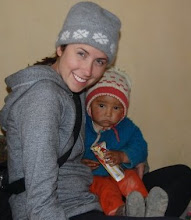

Photo: A snapshot of Lahan. A city in Nepal's Terrai region near the border of India
The trip was nothing short of eventful.
Perhaps I should be begin with what Mike (my calm and collected colleague) and I now fondly refer to as the “bus ride of death.” Hand-on-horn, our driver sped like he had some kind of death wish - dodging oncoming traffic and several ominous cliff drops by inches. I couldn’t figure out why he gave the entire bus plastic bags before departing from Kathmandu. But when a good chunk of the passengers began throwing up in them through the windy mountain roads it became quite clear.
After dropping our stuff off at a motel we hit the villages with Rakesh, our trustworthy guide and translator. If I’ve learned anything in the past few weeks it is to always expect the unexpected. It wasn’t long before our driver drove the jeep directly into a sand trap and we had to dig it out with the help of 20 Nepali locals. Did I mention it was 45 degrees?

Photo: A somewhat feeble attempt to push the jeep out of the sand.
During our second day of shooting we planned to travel by bus to Biratnagar - the second largest city in Nepal - to follow a group of women who were scheduled to receive surgery for fallen womb. Only on this day an opposition political party had called a bandh (or strike). It’s a common occurrence in Nepal. When a group doesn’t like a certain policy they ostensibly shut the region down. No one really drives for fear of being lobbed with rocks, or, worse, having their vehicles burned.
The aid organization we were with took the risk and rented two vans. With all the NGO papers on-hand the plan was to try and smooth over the protestors if stopped.Thankfully we were never stopped. But while we made it to Biratnagar safe and sound, we were too late at the hospital and they refused to admit the women until the following morning. The hospital’s suggestion? For the women to sleep on the floor of the waiting room for the night.
Having a camera certainly worked in our favour in this case as the smooth-talking director of the hospital eventually agreed to admit the women after I explained to him that we were planning to document whatever unfolded if these poor women did not receive a bed.
So we spent the night in Biratnagar, which, I can say with certainty has not left me with the fondest of memories.
Enter the green motel that looked as if someone had thrown up split pea soup all over it... in every conceivable shade of green (and even a few I never knew existed). No electricity that night, so we slept in the heat fending off mosquitos. I have had a few vivid dreams about the green motel since - none pleasant and all of which ended like an Alfred Hitchcock movie. I’ll leave it there.

Photo: The Green Motel (in case I didn't do it justice)
All kidding and recounting aside, it was certainly the most difficult few days I have experienced in a long time. But an incredibly eye-opening journey - one which I am very grateful for. While there is nothing glamorous about this work, it feels right. And I am learning so many things every day.
The poverty in the Terai is quite astounding. There is no electricity, little water and even less food. As a journalist it was difficult to listen to what seemed like an endless supply of heart-wrenching stories. As a human being it was much harder to leave at the end of the day. There are hundreds of thousands in need in the region. The problem seems so vast and crushing it is overwhelming at times.
I hope the documentary will tell the story like how I experienced it with my own eyes.














